Author: Will Owens, Research Analyst at Galaxy Digital
Translation: Golden Finance xiaozou
With the emergence of digital asset treasury companies and Bitcoin prices breaking historical highs, people have gradually forgotten the core value proposition of the Bitcoin network: a decentralized, censorship-resistant monetary system aimed at providing permissionless global value transfer.
Since the decline of non-monetary activities of the Runes protocol and Ordinals protocol at the end of 2024, on-chain usage of Bitcoin has sharply shrunk. Today, we see an increasing number of "free" or nearly free blocks, meaning the average transaction fee paid per virtual byte (the standard unit measuring Bitcoin transaction size) is only 1 satoshi (one hundred millionth of a Bitcoin) or even lower. While this is a short-term benefit for users seeking cheap and fast transfers, it adds a burden to the mining economy, which is already under pressure from the 2024 halving.
This article analyzes the structure of the Bitcoin fee market, assesses the real dynamics on-chain and their impact on the health of the network economy, while also examining the evolution of OPRETURN transactions and their usage patterns. Given the controversy surrounding the upcoming v30 version of the Bitcoin core client—which will allow larger capacity and more OPRETURN outputs in a single transaction by default—this analysis is particularly relevant. Some members of the Bitcoin community are concerned that this move will lead to an influx of spam transactions, and have sharply criticized the proposed update.
Summary
The pressure on Bitcoin transaction fees has collapsed: since April 2024, the daily median fee has dropped by over 80%; as of August 2025, about 15% of daily blocks are "free blocks."
OPRETURN activity has experienced a surge and subsequent decline: during the peak adoption period of the Runes protocol (Q2-Q3 2024), OPRETURN transactions often accounted for 40-60% of daily transaction volume; by August 2025, this proportion has dropped to about 20%.
Mempool activity is scarce: in recent months, the proportion of non-full blocks has repeatedly surged to nearly 50%; after the 2024 halving reduced the block reward to 3.125 BTC, the quiet mempool may pose challenges to the long-term sustainability of miner income.
On-chain activity may be replaced by alternative solutions: the spot Bitcoin ETF currently holds about 1.3 million BTC, most of which have not undergone substantial on-chain transfers; trading and speculative activities are shifting to alternative Layer 1s like Solana, especially in use cases such as meme coins and NFTs.
Over 1.5 million BTC are still stored in traditional P2PK addresses: these bare public key addresses are considered highly vulnerable to potential quantum computer attacks due to the public key being always exposed on-chain.
Over 6 million BTC are still stored in traditional P2PKH addresses.
The P2 WPKH address format currently holds the largest share of unspent BTC.
1. Method
All on-chain data in this article comes from Galaxy's internal Bitcoin infrastructure, including our self-built full nodes. Unless otherwise specified, the statistics reflect the state of the Bitcoin network as of August 12.
Fee Metrics: Calculated using block-level data, including average/median fees, the proportion of "free blocks" (blocks with average fees ≤ 1 satoshi/virtual byte), and the proportion of non-full blocks. In this study, we define blocks with a total weight below 3.9 million weight units (relative to a maximum of 4 million) as non-full.
OPRETURN Analysis: By analyzing transaction data to identify transactions containing the OPRETURN opcode. The daily proportion of OP_RETURN transactions is expressed as the percentage of such transactions relative to the total transaction volume for that day.
Address Format Classification: Unspent outputs are classified by script type (e.g., P2PKH, P2PK, P2SH, P2TR, P2WPKH). The total balance statistics are as of August 12.
2. Current State of the Fee Market
The Bitcoin fee market—a mechanism where users bid to have their transactions included in the next block—has entered a stagnation phase. While almost all Bitcoin transactions come with fees, users can choose the amount they wish to pay, and transactions with higher fees typically confirm faster. After months of network congestion caused by Bitcoin fungible/non-fungible tokens (Runes and Ordinals), the current network fee pressure has sharply diminished. The average daily transaction fee has dropped to its lowest level since early 2023.
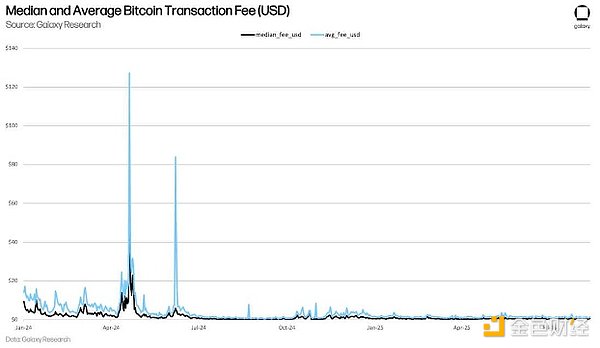
While average and median fees effectively summarize market trends, they do not reflect the full picture. The following chart presents data through more refined dimensions: daily transaction fee percentiles calculated by virtual byte price (satoshi/vB).
This chart covers the time span from January 2023 to the present, displaying the fee levels at the 10th, 25th, 50th (median), 75th, and 90th percentiles. This perspective not only reflects changes in the median but also fully presents the evolution of mempool fee pressure, clearly revealing the sharp narrowing of fee differentials since the end of 2024.
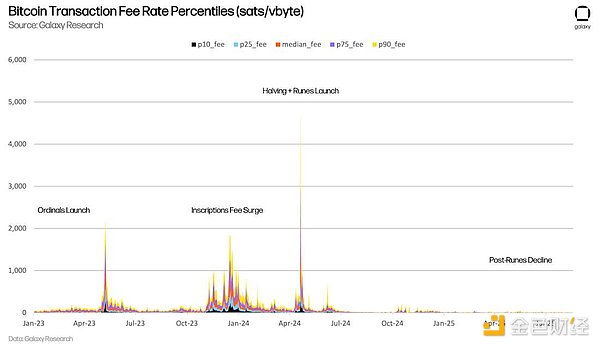
The most direct manifestation of this trend is the surge in the number of "free blocks" (blocks with average fees ≤ 1 satoshi/vB). Such blocks were virtually nonexistent in 2024 but have become increasingly common today. As of the writing of this article, free blocks account for a significant proportion of daily produced blocks, fully confirming the collapse of competition for block space.
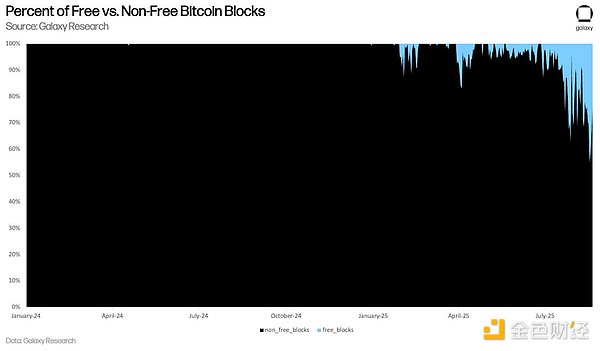
At the same time, the proportion of "non-full" blocks remains high. These blocks still have space to accommodate more transactions but have not reached the 4 million weight unit cap. In short, Bitcoin's mempool (the waiting area for pending transactions) is often in a state of vacancy; even when it is not empty, it is filled with transactions that can be processed quickly without paying high fees.
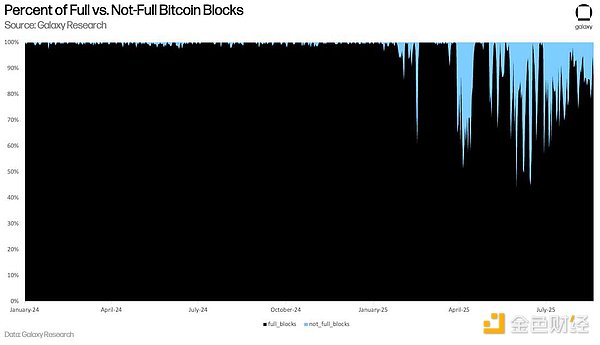
For miners, this phenomenon is concerning. The 2024 halving has reduced the block reward to 3.125 BTC, and it was originally expected that transaction fees would play a more significant role in miner income, but the reality is that fee income has dried up. The long-term economic model of Bitcoin network security relies on a healthy fee market, and the current market conditions are far from "healthy."
The rise of custodial solutions and "Bitcoin paper wallet" products (whether ETFs or other institutional derivatives) may be suppressing on-chain activity. Meanwhile, meme coin traders are accelerating their migration to faster and cheaper Layer 1s like Solana—when the meme coin trading experience on Solana is so smooth, enduring the poor user experience of the Runes protocol is clearly not worth it.
3. OP_RETURN Opcode
The Bitcoin OPRETURN opcode was introduced in 2014, allowing users to embed up to 80 bytes of arbitrary data in transaction outputs. These outputs have verifiable unspendability and typically carry no BTC value, thus not increasing the size of the unspent transaction output (UTXO) set. UTXOs are discrete units of Bitcoin that wallets can use for future transactions, forming the cornerstone of the Bitcoin accounting system—each transaction consumes existing outputs and generates new outputs. If BTC is sent to an OPRETURN output, those coins will be permanently locked, but in return, a new use case is created: permanently storing information or metadata on the blockchain.
The usage of this script type has surged in the past 18 months. During the peak adoption period of the Runes protocol in April 2024 (block height 840,000, coinciding with the last miner block reward halving), OP_RETURN transaction volume reached historic highs. As shown in the following chart, these non-monetary transactions dominated block space during the peak period.
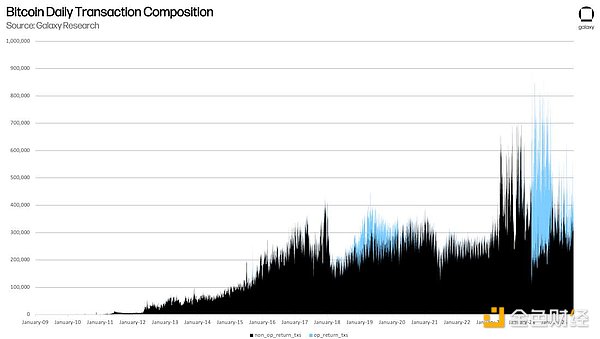
As Runes activity has cooled, current OPRETURN usage has gradually declined. However, developers and institutions continue to utilize it for anchoring data on-chain. For example, a few weeks ago, Galaxy broadcast a historic client transaction of 80,000 BTC via OPRETURN.
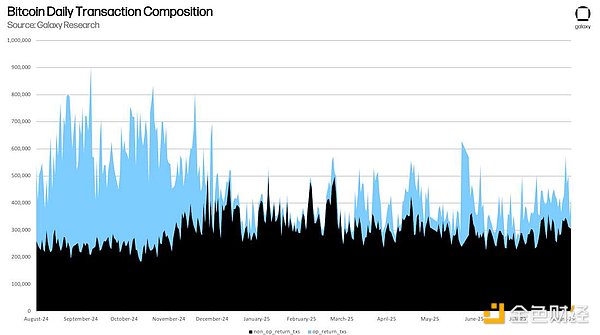
OPRETURN is being assigned innovative uses. An organization named after the legendary Wall Street investment bank Salomon Brothers has begun using OPRETURN to send legal notices to dormant Bitcoin wallets. These on-chain messages invoke the "abandonment principle," requiring wallet owners to respond within 90 days, or "Salomon" (the organization holds the trademark but is unrelated to Citigroup, which inherited the original investment banking business) will claim the right to recover funds on behalf of clients (though how this organization controls these wallets remains unclear).
Although this is an innovative practice of directly anchoring legal documents to Bitcoin, it has sparked controversy in the context of the upcoming version 30.0 update of the Bitcoin core client. This soon-to-be-released open-source software will relax the default limits on OPRETURN data payloads, allowing a single transaction to include larger capacities and multiple data outputs. Critics point out that while OPRETURN outputs do not inflate the UTXO set (due to their verifiable unspendability), they still occupy block space, potentially crowding out monetary transactions and threatening the long-term sustainability of the network. The Bitcoin core development team responded that the ultimate decision on whether to forward or package larger OP_RETURN transactions still lies with node operators and miners.
4. Bitcoin Holdings by Script Type
While fee trends can reflect short-term dynamics in Bitcoin, the UTXO set itself reveals the long-term distribution of BTC within the network. By classifying unspent outputs by script type (i.e., address format), we can observe the adoption of various address types and their implications for spendability, security, and resistance to quantum computing.
The P2PKH (Pay-to-PubKey-Hash) format became mainstream after the early stages of Bitcoin and still holds a significant amount of BTC (over 6 million). However, newer formats have gradually gained popularity in recent years: the P2WPKH (native SegWit) introduced in 2017 has become the largest holder of unspent BTC, while the P2TR (Taproot) introduced in 2021 is steadily growing, supporting more advanced script use cases.
The following chart shows the balance distribution of each script type as of August 11. This data also provides a basis for discussions on future security risks.
The traditional P2PK (Pay-to-PubKey) format was primarily used for early coin creation transactions and is inherently vulnerable to quantum computing attacks—because this format exposes the complete public key on-chain when unspent.
Other formats do not expose the public key before the output is spent. However, once spent (especially when addresses are reused), the public key will also be exposed, putting these coins at similar risk.
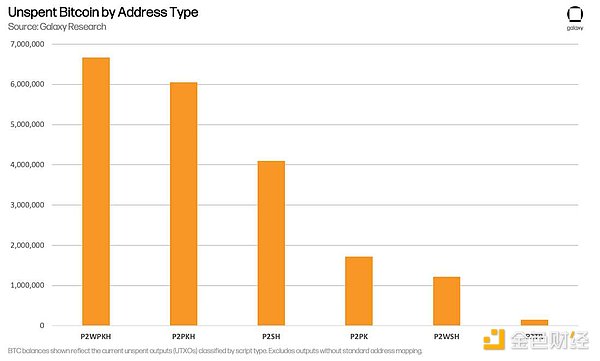
5. Conclusion
On-chain activity in Bitcoin has entered a period of stagnation, but the network infrastructure continues to evolve.
In the short term, low fees benefit users looking to consolidate UTXOs or transfer assets at low cost. However, the long-term outlook is more ambiguous—the shrinkage of the fee market raises substantial questions about network security.
With the block reward reduced to 3.125 BTC, miner incentives increasingly rely on fluctuations in organic demand. If more BTC transaction volume continues to flow to ETFs, custodial institutions, and high-speed competitive chains, the core network may become a settlement layer lacking sufficient settlement activity.
As the scale of "Bitcoin paper wallets" expands and fee income stagnates, the Bitcoin security model is increasingly dependent on a usage demand that is no longer guaranteed. While fee volatility is not a new phenomenon, Bitcoin indeed needs more substantial reasons for on-chain usage.
免责声明:本文章仅代表作者个人观点,不代表本平台的立场和观点。本文章仅供信息分享,不构成对任何人的任何投资建议。用户与作者之间的任何争议,与本平台无关。如网页中刊载的文章或图片涉及侵权,请提供相关的权利证明和身份证明发送邮件到support@aicoin.com,本平台相关工作人员将会进行核查。




